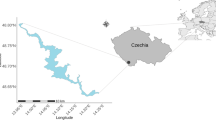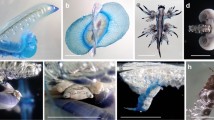Abstract
The deep-water rose shrimp, Parapenaeus longirostris (Lucas 1846, Decapoda: Penaeidae) is one of the main target species of the demersal fishery in the Moroccan Atlantic region. However, in the last decade, there is a severe decline of shrimp fisheries in the area without the existence of any management plan. The purpose of this article is to investigate the relationships between the spawning of the deep-water rose shrimp and environmental factors in order to provide basic information for any future management measure. The spatial distribution of mature females is investigated through statistical techniques on data collected in the Moroccan Atlantic Ocean from bottom trawl surveys during 1981–2004. The geographic distribution of mature females is jointly analyzed in association to the spatial distribution of salinity and temperature at the depth of species catch. The study reveals a strong relationship between locations of spawning females and high salinity. Most spawning occurrences are observed in high salinity ‘islands’ (35.6–36.5 psu) or in the boundaries of higher-lower salinity patterns in the specific range of 36.2–36.4 psu in shallower (75–200 m) and deeper zones (250–500 m). Spawning occurs mostly in the shallower zone from spring to summer while during winter, it occurs in both depth zones. Temperature seems to be important on catch levels of the species.









Similar content being viewed by others
References
Abdel Razek, F. A., S. S. El-Sherief, S. M. Taha & E. G. Muhamad, 2006. Some biological studies of Parapenaeus longirostris (Lucas, 1846) (Crustacea: Decapoda) in the Mediterranean coast of Egypt. Egyptian Journal of Aquatic Research 32: 385–400.
Abrantes, F., H. Meggers, S. Nave, J. Bollmann, S. Palme, C. Sprengel, J. Henderiks, A. Spies, E. Salgueiro, T. Moita & S. Neuer, 2002. Fluxes of micro-organisms along a productivity gradient in the Canary Islands region (29° N): implications for paleoreconstructions. Deep-Sea Research II 49: 3599–3629.
Akaike, H., 1973. Information theory and an extension of the maximum likelihood principle. In Petrov, B. N. & F. Csaki (eds), Proceedings of the 2nd International Symposium on Information Theory. Publishing House of the Hungarian Academy of Sciences, Budapest: 268–281.
Ardizzone, G. D., M. F. Gravina, A. Belluscio & P. Schintu, 1990. Depth-size distribution pattern of Parapenaeus longirostris (Lucas, 1846) (Decapoda) in the central Mediterranean Sea. Journal of Crustacean Biology 10: 139–147.
Ashton, W. D., 1972. The Logit Transformation with Special Reference to its Uses in Bioassay. Charles Griffin & Co. Ltd, London, England.
Audoin, J., 1965. Répartition bathymétrique des crevettes sur les côtes algériennes entre les îles Zaffarines et les îles Habibats. Rapports Commission Internationale pour l’Exploration Scientifique de la Mer Méditerranée 18/518: 171–174.
Barrett, B. B. & M. C. Gillespie, 1973. Primary factors which influence commercial shrimp production in coastal Louisiana. Wildlife and Fisheries Communication Technical Bulletin 9: 1–28.
Barrett, B. B. & M. C. Gillespie, 1975. Environmental conditions relative to shrimp production in coastal Louisiana. Wildlife and Fisheries Communication Technical Bulletin 15: 1–22.
Bayed, A. & M. Glémarec, 1987. La plate-forme continentale Atlantique nord-Marocaine: Bionomie et Zoogéographie. Oceanologica Acta 10: 111–121.
Bayhan, K., T. Unluer & M. Akkaya, 2005. Some biological aspects of Parapenaeus longirostries (Lucas, 1846) (Crustacea, Decopoda) inhabiting the Sea of Marmara. Turkish Journal of Veterinary and Animal Science 29: 853–856.
Belvèze, H., A. Berraho, A. Chaali, A. Idelhaj & A. Lahlou, 1982. Périodes et zones de reproduction des principales espèces halieutiques dans les eaux Marocaines et possibilités éventuelles d’aménagement. Note d’information, Institute Pêches Maritime, Maroc, Casablanca: 2–22.
Benchoucha, S., 2005. Etude de la biologie de la crevette rose du large (Parapenaeus longirostris, Lucas, 1846) de la côte Atlantique marocaine. Mémoire DESA. Université Hassan II, Aïn Chock, Casablanca.
Berry, R. J. & K. N. Baxter, 1969. Predicting brown shrimp abundance in the northwestern Gulf of Mexico. FOA Fisheries Report 3: 776–798.
Bertrand, J., L. G. De Sola, C. Papaconstantinou & G. Relini, 1997. An international bottom trawl survey in the Mediterranean: the MEDITS Programme. ICES Annual Science Conference Y:03: 1–7.
Boyer, T., S. Levitus, H. Garcia, R. A. Locarnini, C. Stephens & J. Antonov, 2005. Objective analyses of annual, seasonal, and monthly temperature and salinity for the World Ocean on a 0.25° grid. International Journal of Climatology 25: 931–945.
Burnham, K. P. & D. R. Anderson, 2002. Model Selection and Multimodel Inference: A Practical Information-theoretic Approach. Springer-Verlag, New York.
Caddy, J. F. & S. Garcia, 1982. Production modelling without long data series. FAO Fisheries Report 238: 309–313.
Carr, M.-E., 2002. Estimation of potential productivity in eastern boundary currents using remote sensing. Deep-Sea Research II 49: 59–80.
Cervantes, A. & R. Goni, 1986. Composición por tallas de la captura española de la Gamba blanca (Parapenaeus longirostris Lucas, 1846) en el área de CECAF. Division 34.1.1 COPACE/PACE Series 86/33: 240–245.
Cervantes, A., I. Sobrino, A. Ramos & L. Fernandez, 1991. Descripción y análisis de los datos de las pesquerías de merluza y gamba de la flota española que faeno al fresco en África noroccidental durante el periodo 1983–1988. Informes Técnicos Instituto Español de Oceanografía 111: 85.
Charmantier-Daures, M., P. Thuet, G. Charmantier & J. P. Trilles, 1988. Tolérance à la salinité et osmorégulation chez les post-larves de Penaeus japonicus et Penaeus chinensis. Effet de la température. Aquatic Living Resources 1: 267–276.
Cochran, W. G., 1963. Sampling Techniques. John Wiley & Sons, New York.
Crosnier, A., E. De Bondy & S. Lefèvere, 1968. Les crevettes commercialisables de la côte ouest de l’Afrique intertropicale. Etat de nos connaissances sur leur biologie et leur pêche en juillet 1967. Rapports Scientifiques et Techniques. Sciences de la Mer. Biologie marine. Centre de Noumea ORSTOM 7: 60.
D’Onghia, G., F. Mastrototaro, P. Maiorano & M. Basanisi, 1998. Selettività della rete a strascico utilizzata sui fondi di scarpata (250–750 m) dello Ionio (Mediterraneo Centrale). Biologico Mare Mediterranea 5: 437–448.
FAO, 2004. FAO Statistical Yearbook. Statistics Division. FAO, Rome: 318.
FAO, 2005. The State of Food Insecurity in the World 2005. FAO Economic and Social Department. FAO, Rome: 40.
FAO, 2007. Guide to Bycatch Reduction in Tropical Shrimp–Trawl Fisheries. FAO, Rome: 120.
Fogarty, M. J., 1985. Statistical considerations in the design of the trawl-survey. FAO Fisheries Circular 786: 1–21.
Froglia, C., 1982. Contribution to the knowledge of the biology of Parapenaeus longirostris (Lucas) (Decapoda, Penaeidae). Quaderni del Laboratorio di Tecnologia della Pesca 3: 163–168.
Heldt, J. H., 1938. La reproduction chez les crustacés décapodes de la famille des Pénéidés. Annales de l’Institut Océanographique 18: 31–206.
Holthuis, L. B., 1987. Crevettes. In Fischer, W., M. Schneider & M. L. Bauchot (eds), Fiches FAO d’identification des espèces pour les besoins le la pêche. Méditerranée et Mer Noire. Zone de pêche 37. Végétaux et invertébrés: 271–272.
Karlovac, O., 1949. Le Parapenaeus longirostris (H. Lucas) de la haute Adriatique. Acta Adriatica 3: 407–416.
Massuti, M., 1963. La pêche des crustacés aux Baléares (Méditerranée occidentale) et dans l’Atlantique sud (Golfe de Cadix). C.G.P.M. Débats et Document Technique 7: 191–202.
Maurin, C., 1960. Les crevettes profondes du littoral français de la Méditerranée. Répartition selon la profondeur. Notes biométriques. Rapports Commission Internationale pour l’Exploration Scientifique de la Mer Méditerranée 15: 147–154.
Munro, J. L., 1980. Stock assessment models: applicability and utility in tropical small-scale fisheries. In Saila S. B. & P. H. Roedel (eds), Stock assessment for tropical small-scale fisheries. Proc. Intern. Workshop Sept. 1979, Univ. Rhode Island. Int. Cent. Mar. Res. Dev. Kingston, R.L.: 1–198.
Olaso, I., 1990. Distribución y abundancia del megabentos invertebrado en fondos de la plataforma Cantábrica. Publicaciones Especiales Instituto Español de Oceanografía 5: 1–128.
Perez-Farfante, I., 1982. The geminate shrimps species Parapenaeus longirostris and Parapenaeus politus. Quaderni del Laboratorio di Tecnologia della Pesca 3: 187–205.
Perez-Farfante, I. & B. Kensley, 1997. Penaeoid and Sergestoid shrimp and prawns of the world. Key and diagnose for the families and genera. Memoires du Museum National d’histoire Naturelle 175: 1–233.
Pestana, G., 1991. Stock assessment of deep water rose shrimp (Parapenaeus longirostris) from the southern Portugal (ICES Division IXA). ICES CM1991/K/46: 29.
Pestana, G. & A. Ribeiro-Cascalho, 1991. Effects of changing trawl mesh size and fishing effort of deep water rose shrimp (Parapenaeus longirostris) from the southern Portugal (ICES, Division IXa). ICES CM1991/K/45: 18.
R Development Core Team, 2005. R: A Language and Environment for Statistical Computing. R Foundation for Statistical Computing, Vienna. http://www.R-project.org.
Relini, G., J. Bertrand & A. Zamboni, 1999. Synthesis of the knowledge on bottom fishery resources in central Mediterranean, Italy and Corsica. Biologia Maritima Mediterranea 6: 868.
Relini, G. & C. Piccinetti, 1996. Ten years of trawl surveys in Italian seas (1985–1995). FAO Fisheries Report 533: 21–41.
Ribeiro-Cascalho, A. & I. Arrobas, 1983. Further contributions to the knowledge about biology and fishery of Parapenaeus longirostris (Lucas, 1846) of South Portuguese coast. ICES CM1983/K/26: 26.
Ribeiro-Cascalho, A. & I. Arrobas, 1987. Observations on the biology of Parapenaeus longirostris (Lucas, 1846) from the south coast of Portugal. Investigacion Pesquera 51: 201–212.
Sobrino, I. & T. Garcia, 1991. Analisis y descripcion de las pesquerias de crustaceos decapodos en aguas de la Republica Islamica de Mauritania durante el periodo 1987–1990. Informes Tecnicos Instituto Espanol de Oceanografia 112: 1–38.
Sobrino, I. & T. Garcia, 1992a. Análisis y descripción de la actividad de la flota española en las pesquerías de crustáceos decapodos profundos en aguas de la Republica de Senegal durante el periodo 1987–1990. Informes Técnicos Instituto Español de Oceanografía 125: 1–37.
Sobrino, I. & T. Garcia, 1992b. Análisis y descripción de las pesquerías españolas de crustáceos decapodos en aguas de la Republica de Guinea Bissau durante el periodo 1987–1991. Informes Técnicos Instituto Español de Oceanografía 135: 1–38.
Sobrino, I. & T. Garcia, 1994. Biology and fishery of the deep water rose shrimp Parapenaeus longirostris (Lukas, 1846) from the Atlantic Moroccan coast. Scientia Marina 58: 299–305.
Sobrino, I., T. Garcia & J. Baro, 2000. Trawl gear selectivity and the effect mesh size on the deep water rose shrimp (Parapenaeus longirostris, Lucas, 1846) fishery off the Gulf of Cadiz (SW Spain). Fisheries Research 44: 235–245.
Sobrino, I., A. Garcia, E. Garcia-Isarch, L. Silva, J. Baro & J. Mas, 2005. Estudio previo para la delimitacion de una reserva de pesca en la desembocadura del Guadalquivir. Junta de Andalucía, Consejería de Agricultura y Pesca: 205.
Sobrino, I., M. P. Jiménez, F. Ramos & J. Baro, 1994. Descripción de las pesquerías demersales de la región sur atlántica española. Informes Técnicos Instituto Español de Oceanografía 151: 79.
Spedicato, M. T., G. Lembo, T. Silecchia & P. Carbonara, 1996. Distribuzione e biologia di Parapenaeus longirostris nel Tirreno Centro-Meridionale. Biologia Maritima Mediterranea 3: 579–581.
Williams, A. B., 1969. A ten-year study of meroplankton in North Carolina estuaries: cycles of occurrence among penaeidean shrimps. Chesapeake Science 10: 36–47.
Author information
Authors and Affiliations
Corresponding author
Additional information
Guest editor: V. D. Valavanis
Essential Fish Habitat Mapping in the Mediterranean
Rights and permissions
About this article
Cite this article
Benchoucha, S., Berraho, A., Bazairi, H. et al. Salinity and temperature as factors controlling the spawning and catch of Parapenaeus longirostris along the Moroccan Atlantic Ocean. Hydrobiologia 612, 109–123 (2008). https://doi.org/10.1007/s10750-008-9485-y
Published:
Issue Date:
DOI: https://doi.org/10.1007/s10750-008-9485-y




